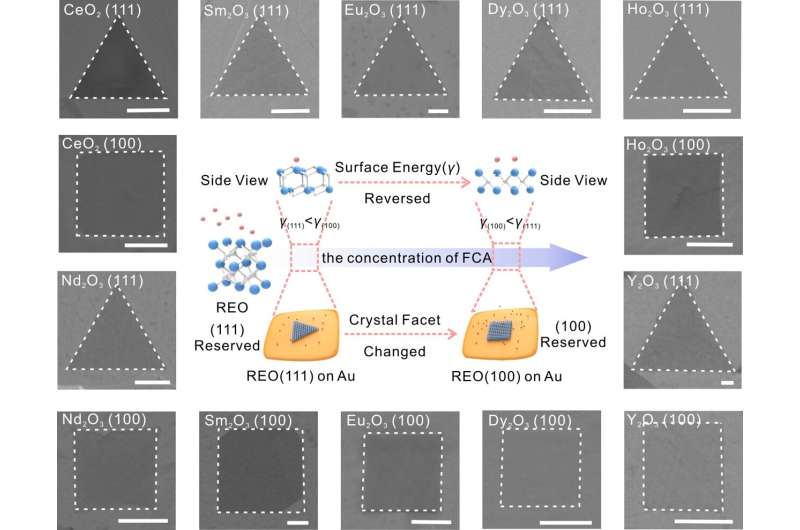The center schematic diagram exhibits the facet transition process of 2D REOs single crystals via the surface energy engineering assisted by FCA. The SEM images around show a series of 2D REOs single crystals exposing different facets, scale bar: 1 μm. Credit: Science China Press
Since graphene was awarded the Nobel Prize in 2010, two-dimensional (2D) materials have continued to attract researchers' attention in logic, storage, optoelectronic and photonic 2D device manufacturing fields because of the atomic thickness and excellent performance. Based on the research of graphene, scientists have discovered some other 2D materials, such as layered transition metal dichalcogenides (TMDs), hexagonal boron nitride (h-BN), and non-layered III–V group semiconductors.
Recently, 2D rare earth oxides (REOs) have arisen as a unique and promising non-layered material family. The unfilled 4f orbitals of rare earth elements are shielded by the fully filled outer shell, thus the unpaired 4f electrons of rare earth ions are typically not involved in chemical reactions, leading to promising properties in luminescence, magnetic, electronics and catalytic activities. 2D REOs combine the unique properties of rare earth elements and have been widely used in optics, magnetism, high-efficiency catalysts, transistors, biomedicine and other fields.
Besides, it is reported that the crystal facet also has a certain influence on the properties of the 2D materials. Therefore, it is very significant to controllably synthesize 2D materials with specific facets. However, due to its non-layered structure, it is challenging to control the 2D anisotropic growth of the material. Moreover, since 2D materials will expose the most stable facet with the lowest energy, it is particularly important to control the thermodynamics of the materials.
In response to these challenges, recently, in a recent research article published in the National Science Review, scientists at Wuhan University, China presented a new paradigm and realized the facet controllable synthesis of a series of non-layered 2D REOs. Introducing a facet controlling assistor (FCA) can control the 2D nucleation of the predetermined facets and adjust the growth mode and direction of crystals.
The authors stated: "According to the hard-soft-acid-base (HSAB) theory, RE ions are hard acid and prefer to have affinities toward the base. We employed NH4X as the FCA and halide ions belonging to the base act as the active assistor. The introduction of FCA not only controls the 2D nucleation of the predetermined facets and promotes the 2D anisotropic growth of REOs, but also leads to the change in the relative surface energy of each facet with the increasing concentration of FCA and eventually determines the final exposing facet. The strategy can be extended to the facet controllable synthesis of a series of 2D REOs single crystals, including light REOs (CeO2, Nd2O3), middle REOs (Sm2O3, Eu2O3), and heavy REOs (Dy2O3, Ho2O3, Y2O3), respectively."
Taking CeO2 as an example, they systematically studied the atomic structural differences of the grown 2D CeO2(111) and CeO2(100) single crystals. Also, they conducted experiments and DFT calculations to confirm the mechanism further. It is demonstrated that with a low concentration of FCA, the calculated surface energy of CeO2(111) is lower, and 2D CeO2(111) is preferred to be obtained. With the increasing concentration of FCA, the calculated surface energy of CeO2(100) is lower and the corresponding crystal morphology becomes square. They also explored the facet-related paramagnetic properties of 2D REOs single crystals.
"Our versatile work brings forth new insights for realizing the anisotropic growth of non-layered 2D REOs materials and enriches the 2D material family," says Prof. Lei Fu. "Notably, the high maneuverability of this strategy opens up opportunities for designing new materials, studying their properties and potential applications in a wide range."
More information: Linyang Li et al, General synthesis of 2D rare-earth oxides single crystals with tailorable facet, National Science Review (2021). DOI: 10.1093/nsr/nwab153
Provided by Science China Press























